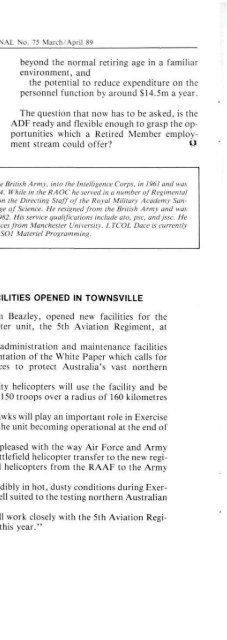ISSUE 75 : Mar/Apr - 1989 - Australian Defence Force Journal
ISSUE 75 : Mar/Apr - 1989 - Australian Defence Force Journal
ISSUE 75 : Mar/Apr - 1989 - Australian Defence Force Journal
- No tags were found...
Create successful ePaper yourself
Turn your PDF publications into a flip-book with our unique Google optimized e-Paper software.
ARMY RECRUIT TRAINING INJURIES "INDEMIC OR EPIDEMIC" 25Treatment- The pain disappears after a shortperiod of rest, but recurs when physicalactivity is resumed.- A Sensation of numbness in the cleftbetween the big toe and second toe.- <strong>Mar</strong>ked weakness in raising the foot(Dorsiflexion).- Local swelling and tenderness overthem muscle belly on the outside of thetibia.- Passive plantar toe flexion will provokepain.- Increased pressure can be measured inthe chronic phase, and it tends to remain.The Recruit/Patient- Rest until pain is resolved.- Apply contrast heat and cold therapy.- Analyse running surfaces, runningtechnique, training, type of shoes, andso on.The Therapist- Treat as for the acute condition, but insiston more rest.The Doctor- Treat as for the acute condition, butfacialotomy may not be ruled out inthese chronic cases.Symptoms and Diagnosis(c) Posterior Deep Compartment Syndrome- Difficult to detect which muscle ormuscles are involved without specific intrinsicexamination.- Increased pressure in the muscle compartmentafter provocation of pain.- Periostitis must be considered (inflammationof periosteum).- Usual course is an increased muscle bulkdue to prolonged intensive training.- Always perform examination afterprovocation.- Pain presents on kicking, taking off, heelraising etc. It starts insidiously andgradually intensifies until physical activityis rendered impossible.- A sensation of numbness in the foot andweakness on taking off from the surface.Treatment- The symptoms abate after resting, butrecur when there is renewed exertion.- The treatment by Recruit, Therapist andDoctor is as for previous acute andchronic conditions in this area.- Treat symptomatically.Medial Tibial Stress (Periostitis ofthe Medial (inside) <strong>Mar</strong>gin of the Tibia"Shin Splints").Symptoms and DiagnosisPerhaps the single most commonly complainedabout condition in this area of the body.- Recruits/athletes who train on alternatingsurfaces, shoes, techniques and constantlyvarying intensities in workload and musclerange of movement, experience thiscommon complaint.- There is tenderness over the distal medialmargin of the tibia and is especially pronouncedover the lower half of the bone.- A certain degree of swelling can be feltand seen.- The pain eases at rest, but returns onrenewed loading (see pain cycle diagram).- Pain is triggered when toes or ankle jointsare bent downwards (plantaflexion).- An X-ray examination is indicated whensymptoms persist (to rule out a stress fracturepossibility).- Pressure in the compartment is usuallynormal.Preventative Measures- Move careful progression in variety andintensity of training programme andtraining areas.- Correct equipment (shoes etc) for thetraining area and surface.-Correct and careful warm-up.Treatment- Training and competition should cease asearly as possible.- Pain is the warning which should signalrest.- Training should not re-commence untilthere is no pain under load conditions,and tenderness over the tibia has gone.- Fitness levels may be maintained by swimmingand cycling etc.

















